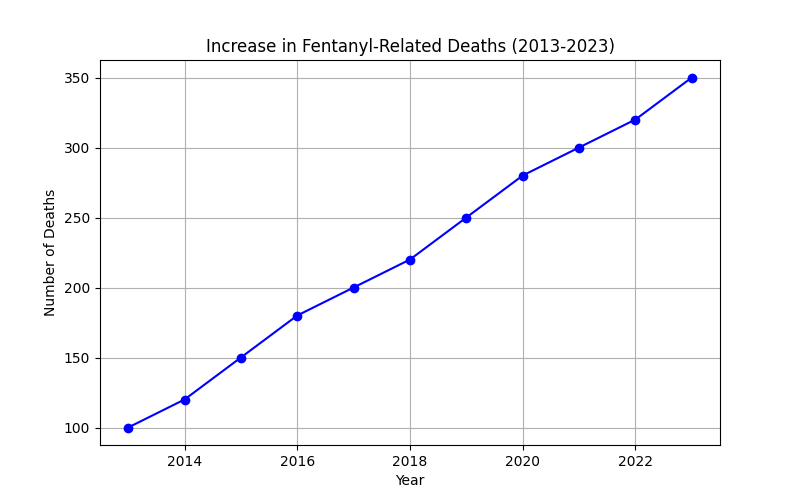Are schools immune to the fentanyl epidemic? Unfortunately, the answer is no. Fentanyl, a synthetic opioid, is highly addictive and dangerous. It is commonly used medically to treat severe pain, but it has become increasingly popular as a recreational drug due to its potent effects. Fentanyl is a growing concern in schools, and it is essential for parents and educators to understand the dangers of fentanyl use, prevention and intervention strategies, and legal implications.
Prevalence of Fentanyl in Schools
Fentanyl is making its way into schools in various ways. It is often sold as counterfeit pills that are made to look like other prescription drugs. Drug traffickers are also mixing fentanyl with other drugs to increase their potency and profitability. Students may also be involved in drug trafficking, either as buyers or sellers.
According to the 2019 National Youth Risk Behavior Survey, 2.5% of high school students reported using fentanyl in the past year. This number may seem small, but it represents thousands of students who are at risk of addiction, overdose, and death.
Fentanyl Epidemic in Schools: What Parents and Educators Need to Know
Fentanyl is making its way into schools, and students are involved in drug trafficking. Fentanyl has short-term and long-term effects, including addiction and withdrawal symptoms. Prevention and intervention in schools, the role of parents, community involvement, and legal implications are essential in addressing the fentanyl epidemic in schools.Dangers of Fentanyl
Fentanyl use poses significant risks to students’ health and well-being. Short-term effects of fentanyl use include drowsiness, confusion, nausea, and respiratory depression. Long-term effects can include damage to the brain, liver, kidneys, and heart. Fentanyl use can also lead to addiction, and withdrawal symptoms can be severe and life-threatening.
The most significant risk of fentanyl use is overdose and death. Fentanyl is so potent that even a small amount can be lethal, and many students may not realize they are taking fentanyl. In 2019, there were over 36,000 overdose deaths involving synthetic opioids, including fentanyl, in the United States.
Prevention and Intervention in Schools
Preventing and intervening in fentanyl use among students requires collaboration between schools, law enforcement agencies, and healthcare providers. Schools can implement drug education programs for students and staff that provide information on the dangers of fentanyl and other drugs, as well as options for getting help.
Counseling and support services are critical intervention strategies for students struggling with addiction or mental health issues. Schools can provide access to these services for students who may be struggling with addiction or mental health issues. Additionally, drug testing policies can be effective in preventing fentanyl use among students. Random drug testing of students who participate in extracurricular activities or who drive to school can deter drug use and identify students who may need help. However, drug testing policies should be implemented with caution and in compliance with the law, as they can raise privacy and legal concerns.
The Role of Parents in Prevention
Parents play a crucial role in preventing fentanyl use among their children. Talking to children about drug use and the risks of fentanyl is essential. Parents should be aware of the signs of drug use, such as changes in behavior, mood, or appearance, and seek help if they suspect their child is using drugs. Parents can also support school prevention programs and work with school officials to address drug-related issues in the community.
Community Involvement in Prevention
Preventing fentanyl use among students requires a community-wide effort. Raising awareness about the dangers of fentanyl and other drugs can help reduce drug use and prevent overdose deaths. Supporting addiction treatment programs and creating drug-free environments in the community can also help. Collaboration between law enforcement agencies and schools can help prevent drug trafficking in the community.
Shop Fentanyl Test Kits
If you are in the market for fentanyl test kits look no further than your security experts right here at Security Pro USA. Click here to view our fentanyl test kits.
Conclusion
The fentanyl epidemic in schools is a significant public health concern that requires immediate attention. Schools, parents, and communities must work together to prevent and intervene in fentanyl use among students. Drug education programs, counseling and support services, drug testing policies, and community-wide efforts can all contribute to preventing fentanyl use. Parents should talk to their children about drug use, be aware of the signs of drug use, and seek help if needed. Legal implications for fentanyl use and trafficking are severe and require collaboration between schools and law enforcement agencies. The fentanyl epidemic in schools is a complex issue, but by working together, we can help keep our students safe and healthy.
Insider Tips:
As a parent or educator, it is essential to stay informed about the latest trends in drug use among students. Keep an open and honest dialogue with your children about the dangers of drugs, including fentanyl. If you suspect your child is using drugs, seek help immediately. Remember, prevention and intervention are key to keeping our students safe and healthy.
FAQs
Who is at risk of fentanyl use in schools?
Students of all ages, especially those with addiction risk factors.
What should schools do to prevent fentanyl use?
Offer drug education programs and provide support for at-risk students.
How can schools detect fentanyl use?
By conducting drug tests and monitoring students’ behavior and attendance.
What if parents object to drug education in schools?
Explain the dangers of fentanyl and the importance of prevention education.
How can schools help students who have already used fentanyl?
Offer counseling services and connect them with addiction resources.
What if schools cannot afford drug education programs?
Seek funding and partnership opportunities with community organizations.

